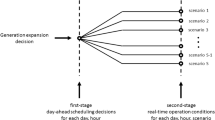Abstract
This paper provides an overview of the California Independent System Operator (CAISO)’s efforts to incorporate environmental policies regarding electric power industry into its probabilistic planning reserve margin studies. Currently, load serving entities such as Investor Own Utilities (IOUs) in the State of California, with its retail load under the jurisdiction of the California Public Utility Commission (CPUC), are required to procure reserve level at 15–17%. This requirement is deterministic in nature and does not include the potential impact of additional reserve requirement due to environmental policies. The CAISO, which controls 80% of the state’s electrical load, is investigating the use of probabilistic planning for planning reserve margin (PRM) of the load serving entities under its operational control. The paper provides an overview of CAISO study results for PRM under various load and resource scenarios, increase in generators’ forced outage rate, and impacts due to California’s environmental policies regarding electric supply sector, such as its once-through cooling (OTC) draft policy and Renewable Portfolio Standards (RPS) targets.











Similar content being viewed by others
Notes
With the RPS target, the load entities would need to meet at a minimum 20% of its retail load electric consumptions with renewable energy for periods before 2020. This target is raised to 33% by 2020 time frame.
The SWRCB’s proposed policy would require the existing once-through cooling power plants to reduce intake flow rate to a level commensurate with that which can be attained by a closed-cycle wet cooling system. The ISO studied a conservative scenario assumption in which the non-nuclear thermal plants are not available in the system due to the need for compliance. This assumption may be considered an extreme scenario, which may not occur, and would serve as a book-end estimate for the worst impact to the State’s generation resources.
“Perfect capacity” is defined as capacity without planned or forced outages.
References
Anders GJ (1990) Probability concepts in electric power systems. Wiley, New York
Billinton R, Allan RN (1996) Reliability evaluation of power systems, 2nd edn. Plenum Press, New York
Billinton R, Li W (1994) Reliability assessment of electric power systems using Monte Carlo methods. Plenum Press, New York
Billinton R, Allan RN, Salvaderi L (1991) Applied reliability assessment in electric power systems. IEEE Press, New York
California Public Utility Code No. 345: http://info.sen.ca.gov/cgi-bin/displaycode?section=puc&group=00001-01000&file=345-352.7
Chowdhury AA, Fung PT, Reppen ND (1997) System capacity reliability assessment using a monte carlo simulation based local area approach. In: Proceedings of PMAPS’ 97 conference, Vancouver, Canada, 20–25 Sept, pp 261–266
Chowdhury AA, Bertling L, Glover BP, Haringa GE (2006) A Monte Carlo simulation model for multi-area generation reliability evaluation. In: The 9th international conference on probabilistic methods applied to power systems, 11–15 June 2006, Stockholm, Sweden, pp 1–10
CPUC, Order instituting rulemaking to consider revisions to the planning reserve margin for reliable and cost-effective electric service. http://docs.cpuc.ca.gov/PUBLISHED/FINAL_DECISION/81530-01.htm#P75_5782
Hammersley JM, Handscomb DC (1964) Monte Carlo methods. Methuen, London
Harringa GE, Jordan GA, Carver LL (1991) Application of Monte Carlo simulation to multi-area reliability evaluations. IEEE Comput Appl Power 4(1):21–25
North American Electric Reliability Corporation (NERC): http://www.nerc.com/files/Reliability_Standards_Complete_Set.pdf
Sheffrin A (2001) Preliminary study of reserve margin requirements necessary to promote workable competition. CAISO Department of Market Analysis, November 19, 2001. http://www.caiso.com/docs/2001/11/20/200111201556082796.pdf
Singh C, Billinton R (1977) System reliability modeling and evaluation. Hutchinson, UK
Tocher KD (1963) The art of simulation. English Universities Press, London
Author information
Authors and Affiliations
Corresponding author
Additional information
Disclaimer: This paper does not in any form and manner reflect the position of the California ISO.
Rights and permissions
About this article
Cite this article
Le, D., Chowdhury, A.A. Modeling environmental policies in probabilistic generation system planning reserve margin assessment. Int J Syst Assur Eng Manag 1, 96–104 (2010). https://doi.org/10.1007/s13198-010-0018-5
Received:
Revised:
Published:
Issue Date:
DOI: https://doi.org/10.1007/s13198-010-0018-5




